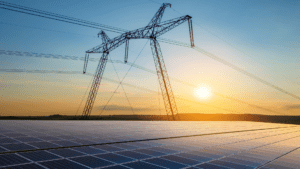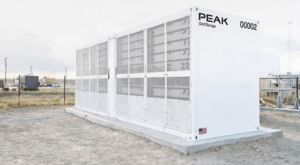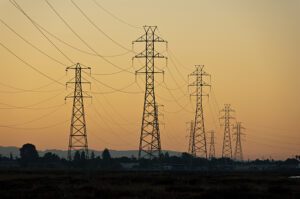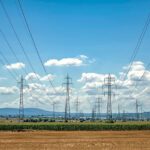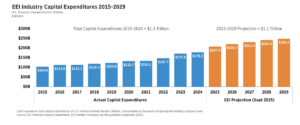
America’s investor-owned electric companies are poised to deploy record-setting investment to launch one of the most aggressive infrastructure modernization campaigns in industry history in a bid to confront unprecedented electricity demand growth and prepare for a fundamentally transformed energy landscape.
In total, over the next five years, the industry is poised to invest more than $1.1 trillion to enhance and expand the grid, according to the Edison Electric Institute (EEI), a trade group that represents all U.S. investor-owned electric companies. That represents an unprecedented accelerated investment pace. By comparison, industry deployed $1.3 trillion over the past 10 years, the research released on Oct. 7 says.
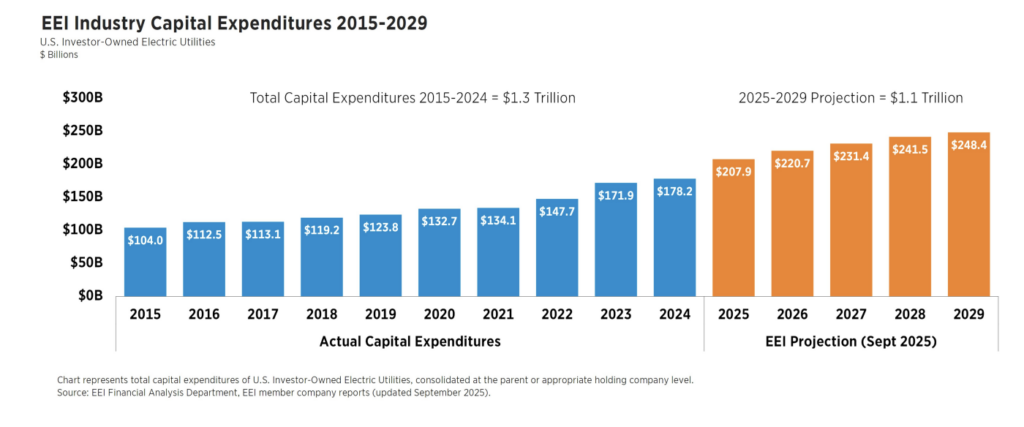
“EEI member companies are on pace to invest nearly $208 billion this year to make the energy grid smarter, stronger, more efficient, and more secure,” the analysis notes. The investment is a direct response to rising demand for energy. Last year, power generation in the U.S. jumped 3% to reach 4,304,038 GWh—marking the “largest annual jump in five years,” it notes. By 2030, U.S. electricity generation could soar to more than 4,500,000 GWh and surpass 5,400,000 GWh by 2040, which would mark an average annual growth of 1.7%.
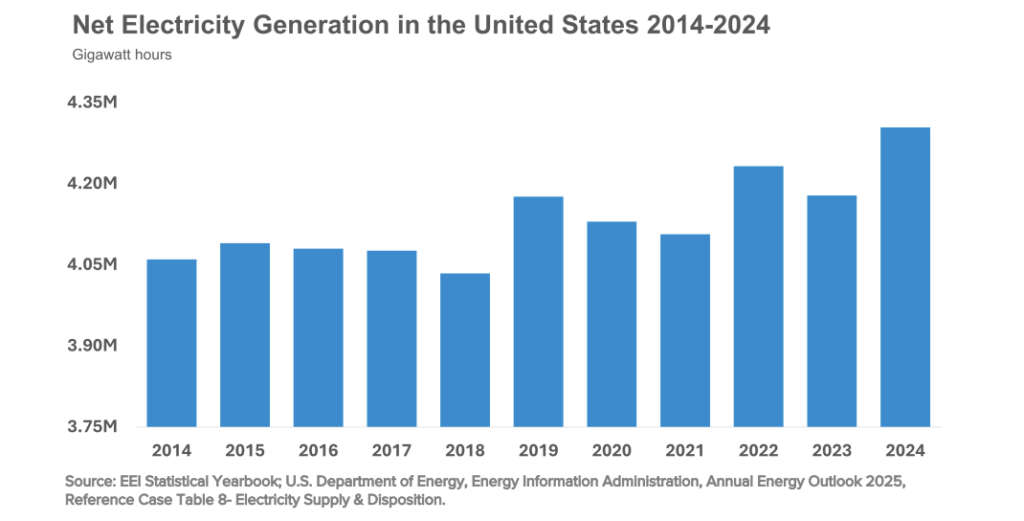
The injection of investment will bolster construction of “more energy- and cost-efficient infrastructure” to meet surging electricity demand,” EEI said. “As the economy electrifies and more electrons flow through the grid, capital expenditures will be distributed across a larger base, driving down costs for everyone,” it noted. EEI added that “these investments will ensure reliability and enable companies to provide electricity at the lowest-possible cost for customers.”
Investment Priorities May Be Shifting Back Toward Power Generation
The scale of planned system expansion also defies historical precedent. EEI suggests 91 GW of new generating capacity is currently under construction, and an additional 488 GW is planned or has been proposed for the next five years. “For comparison, the grid currently has approximately 1,250 GW of capacity,” the report notes. Combined, the 579-GW pipeline represents 46.3% of the nation’s existing grid capacity, and it potentially positions utilities to expand the power system by nearly half its current size within the next half-decade.
The report also suggests the industry’s capital allocation priorities have again shifted markedly toward power generation. While generation investments have represented a rising share of total capital expenditures for four consecutive years, the shift marks a definitive pivot from the previous decade’s emphasis on transmission and distribution modernization, as utilities confront the immediate need for new generating resources to meet exploding demand.
The data show generation spending has nearly doubled since 2020, rising from 24% to 30% of total capex, reflecting a decisive pivot to new power supply amid surging load growth from electrification, AI, and industrial expansion.
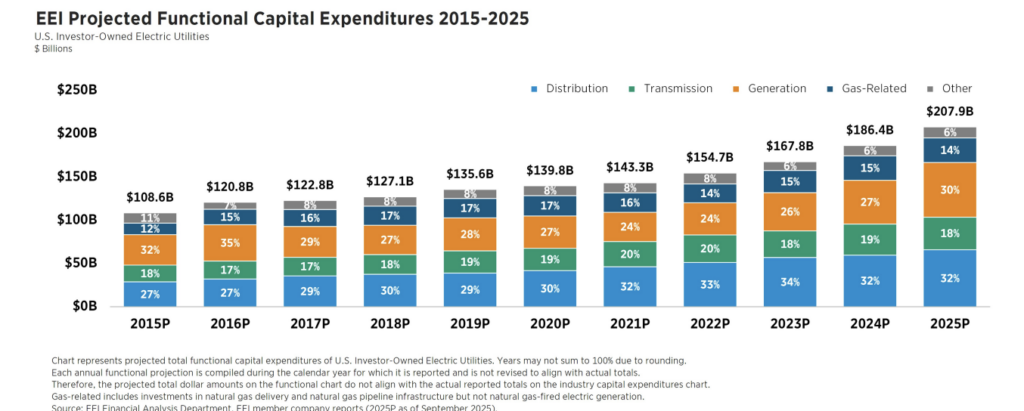
Distribution infrastructure, however, continues commanding the largest investment category within the projected $207.9 billion in functional capital expenditures for 2025, followed by generation, transmission, and gas-related infrastructure investments. The approach reflects a comprehensive system upgrade required to accommodate both increased power flows and changing generation patterns.
A Historic Infrastructure Pipeline Is Emerging
As a whole, total spending by investor-owned utilities is projected to reach $207.9 billion in 2025, up from $139.8 billion in 2020—a nearly 50% increase in five years. For now, distribution is set to remain the single largest spending category, accounting for about one-third ($66.5 billion) of this year’s total, while generation surges to 30% ($62.4 billion)—its highest share in more than a decade. Transmission, meanwhile, will make up roughly 18% ($37 billion), followed by gas-related infrastructure at 14% ($29 billion) and other investments at 6% ($12 billion).
EEI notes that while the gas-related infrastructure category covers natural gas delivery and pipeline infrastructure, it does not cover gas-fired electric generation. Although gas infrastructure’s share has remained relatively stable over the past decade, total gas-related investment has grown by nearly 22% since 2020, likely to improve safety, resilience, and efficiency. But investment also likely supports the industry’s broader grid reliability goals, particularly given that many utilities rely on natural gas networks for winter peak supply and to balance intermittent renewable generation.
The historic surge in capital spending follows decades of incremental, maintenance-driven investment that plugged critical gaps without realigning the grid’s interconnected layers. As POWER reported in its detailed June 2025 feature (“Out of Sync: The Infrastructure Misalignment Undermining the U.S. Grid”), the U.S. power system has long relied on piecemeal upgrades—patching aging lines, retrofitting equipment, and adding local projects in isolation—while generation, transmission, and distribution evolved on disconnected timelines under fragmented regulation. POWER found that reactive approach has left the grid misaligned, and without a coordinated, systemwide vision that synchronizes planning, permitting, and financing across all assets, investment—even if unprecedented—risks entrenching these structural mismatches rather than resolving them.
Resilience, Growing Load Are Key Priorities
According to EEI’s July 2025-released 2024 Financial Review, last year marked EEI member companies’ 13th consecutive year of record capital investment. That report notes members allocated $30 billion to adaptation, hardening, and resilience projects to strengthen the nation’s transmission and distribution infrastructure for all customers.
However, investors, it noted, are primarily focused on AI and data center load growth. “The outlook for data center demand, which has surprised everyone since ChatGPT’s debut in 2022, remained a hot topic across earnings calls, investor conferences, and Wall Street’s industry research in 2024,” the report says.
Load growth forecasts vary wildly. “A McKinsey study predicted data center demand will rise about 20% annually from 2023 to 2030, reaching 170 to 220 GW from 60 GW today. McKinsey noted an alternate scenario could drive demand higher annually to nearly 300 GW,” it notes. “Consultant Grid Strategies published research sourced from FERC filings that concluded that U.S. electricity demand could rise 128 GW over the next five years, with growth focused in six regions of the country. The firm called this a fivefold increase in its forecast from two years ago and said it would raise aggregate load growth to 3% annually in the decade’s second half.” Wall Street’s efforts to quantify the data center demand boost to already rising growth outlooks suggest estimates of 2% or more annual load growth through 2030, it says.
EEI members appear to be watching strong demand growth from data centers with caution. “While new demand is indisputably a good thing, some caution is also understandable,” it notes. “Rate structures need to be optimized to accommodate changing demand. Strong load growth may challenge the electric grid as coal plants retire, large-scale energy storage remains in development, and severe weather highlights the need for continued grid hardening. Many utilities are now also planning new natural gas generation capacity in addition to renewable capacity to keep pace with growing demand.”
In 2024, notably, state regulators and electric companies proposed new tariffs to address growth issues in several states, including California, Georgia, Indiana, Nevada, Ohio, Oregon, and West Virginia. “Resource planning and grid modernization were the most common topics in regulatory proceedings, with over 50 open dockets.”
The report, however, notes that the “longer-term bias” remains an upside. “In recent years investors have generally focused on specific beneficiaries of the AI boom. Utilities are also increasingly seen as an AI beneficiary, which may spark broadened investor interest. Of course, prospects for higher demand growth come from more than AI and data centers. Increased electrification of transportation, manufacturing reshoring, and strong economic development across many service territories are positive factors as well.”
Resilience Despite Revenue Pressures
EEI’s Financial Review serves as a broad indicator of investor-owned utilities’ financial health and prospects, reflecting the aggregated performance of 43 major holding companies covered by the report. The 2024 edition notably surmises that, although nationwide electricity demand increased, “industry revenue decreased, primarily due to lower natural gas prices.” The report found that aggregate energy operating revenues fell 0.1% from 2023, even as U.S. power output rose 2.6%, with gains across eight of the nation’s nine power market regions. “Twenty-one of the 43 companies whose financial results are aggregated reported lower revenue in 2024,” EEI noted.
As a whole, total energy operating expenses in the sector fell for the second straight year, down 9.8%. “Total Electrical Generation Cost fell 6.2% as the average cost of natural gas for electricity generation was 18% lower year-to-year,” EEI wrote, adding that higher output from renewable generation “with zero fuel cost” further constrained aggregate fuel costs. Gas costs for the industry’s natural-gas distribution segment dropped 29.7%.
However, operations and maintenance (O&M) expenses rose 4.7%, reflecting “essential safety and reliability needs” even after years of pandemic-era cost discipline. While O&M spending has “benefitted from productivity gains driven by smart-grid investment,” O&M costs rose for 31 of 42 companies that reported the line item. Meanwhile, depreciation & amortization (D&A) expenses rose 6.9%, slightly above 2023’s 5.8% increase, reflecting ongoing investments in generation, transmission, distribution, reliability, and grid modernization.
Despite cost shifts, the sector’s profitability and financing trends remain positive, the report notes. Generally, operating income rose 2.4% to $88.6 billion, while net income increased 4.5% to $54.6 billion.
State-level regulation remained active in 2024 as utilities sought to recover costs amid rising load growth and infrastructure spending. EEI reported 81 rate reviews filed across 34 states and 78 decided in 32, with the average awarded return on equity rising to 9.73%, up 15 basis points from 2023. Regulators focused on demand growth from data centers and large industrial loads. Several commissions also advanced resilience planning requirements, such as Texas’s first statewide mandate for utility resilience plans, and expanded low- and moderate-income customer protections to address affordability and potential cross-subsidization concerns.
Finally, the report details how capital spending is translating into new capacity. In 2024, investor-owned utilities put online 52,038 MW of new generating capacity—an 11% increase over 2023 and 48% higher than in 2022, according to EEI. Solar led the surge, soaring 63% to 32,486 MW—the fastest annual growth since 2020, while energy storage additions jumped 54% to 11,534 MW. Renewables accounted for 90% of total new capacity in 2024, the fifth straight year in which wind and solar together supplied more than half of new generation. By contrast, natural gas additions fell sharply to 2,428 MW, down 79% yearly, due to a “growing backlog of gas turbine orders.” New plants represented 37% of the year’s total, expansions accounted for 60% and the remaining 3% were rerates, the report notes.
EEI’s projected pipeline of 578 GW of planned and proposed capacity from 2025 through 2029—which, as mentioned above, represents nearly half of the grid’s current capacity—will be dominated by solar, storage, and wind. However, EEI also expects roughly 174 GW of energy storage to come online in that period, a 34% increase from last year’s projection, as utilities race to pair renewables with firming capacity and grid-balancing assets. At the same time, 112 GW of retirements are scheduled through 2029—about half from coal and one-third from natural gas (56 GW and 37 GW, respectively).
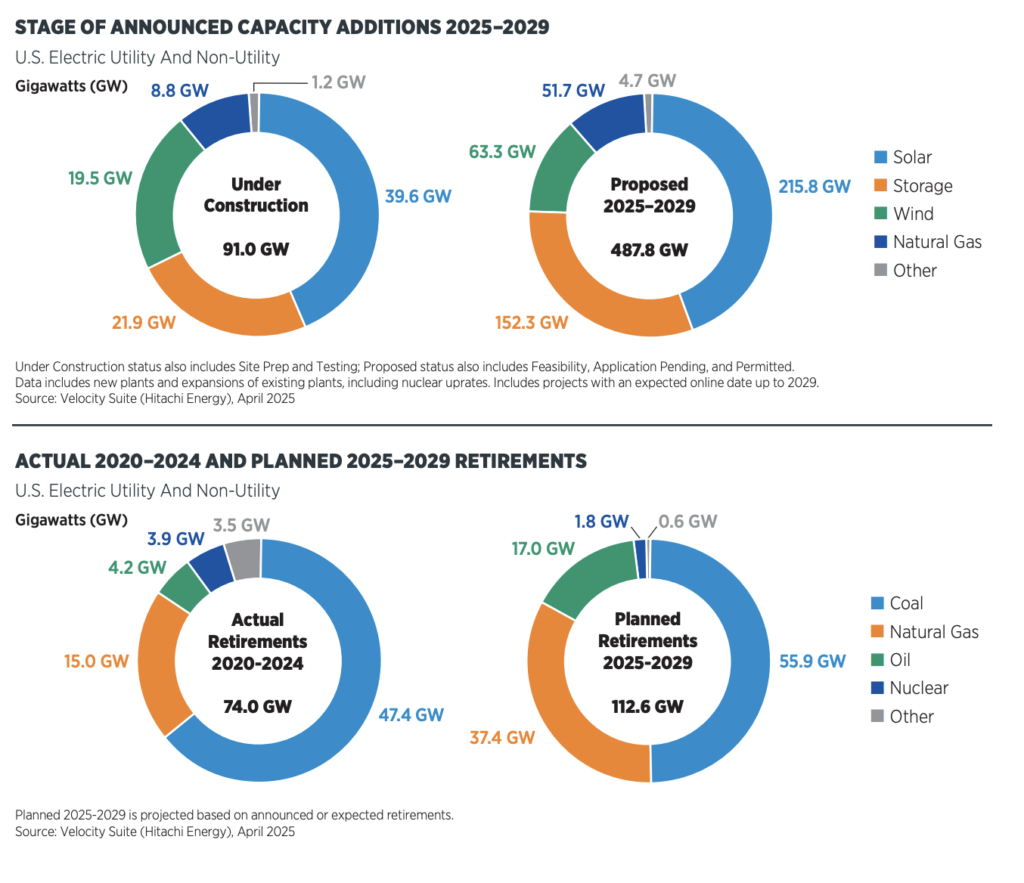
—Sonal Patel is a POWER senior editor (@sonalcpatel, @POWERmagazine).


